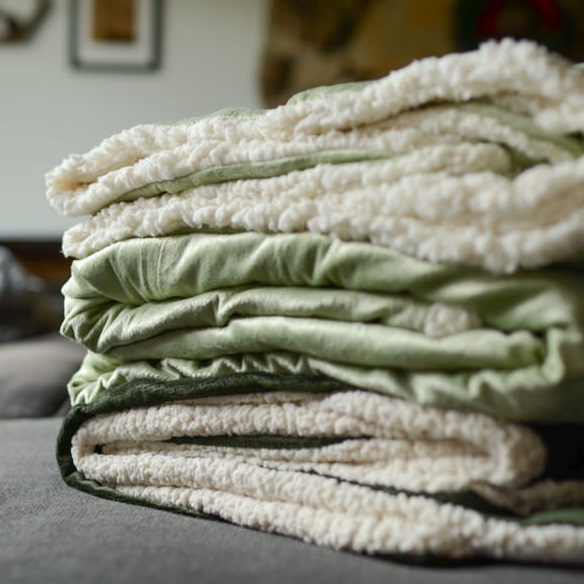What is Fleece?

Fleece is a man-made wonder product, if there is such a thing. Despite being named after the ‘fleece’ coat on a sheep, it’s 100% synthetic and derived from plastic rather than a fluffy sheep’s coat – despite being fuzzy to the touch. The super soft, warm and breathable nature of this magic material makes it perfect for outerwear and all things cosy.
What is Fleece Made From?

Typically, fleece is created from polyester (which comes from plastic). The fibres of polyester are woven into a light fabric which is brushed to help the fibres increase in volume. Occasionally other natural fibres are incorporated into the fleece such as wool, hemp or rayon to create a certain texture or vibrancy of the fabric. Fleece can also be made from recycled plastics such as plastic water bottles, giving it an eco-friendly edge whilst being inexpensive.
How is Fleece Made?
For polyester fleece, the polyester fibres needs to be made first. This is created using a chemical reaction involving petroleum and petroleum derivatives. The chemicals are heated until they form a thick syrup, which then hardens and is spun to form threads. Because of the structure of the fibres, fleece is extremely warm and breathable and allows air to flow through it easily.
Characteristics of Fleece

The characteristics of fleece make it incredibly useful for keeping warm, particularly whilst being active. Fleece has a pile surface on both sides of the fabric, meaning each side has a layer of cut fibres. Air pockets can sit between the threads in this pile surface, meaning the material can hold in that bit more warmth.
Not only is polyester fleece warm and durable, but it is moisture resistant making it ideal for extreme weather conditions or for sportswear which it became popular for in the 1990s, due to it being warmer than wool and much lighter to wear.
What is Fleece Used For?

Fleece has been used for everything from ear-warmers for baby calves, to underwear for astronauts. It’s versatility makes it one of the most commonly used fabrics in the textile industry today.
As mentioned, fleece is the ideal material for athletic garments. The cloth wicks perspiration and moisture away from the body, keeping athletes dry, while letting air circulate through the fibres. It has also been known to keep odours from sweating at bay!
The short pile fabric increases the body temperature when it’s against the skin, making fleece the go-to fabric for warming Winter garments. Coats, scarves, gloves, blankets are often made from this lovely cosy material to create long-lasting and extra warm Winter wear.
Fleece Origins
Fleece originated in the 1970s when Malden Mills developed polyester fleece, which was the basis on which all modern fleece was created. Malden Mills was previously known for producing faux fur and wool garments, and the company wanted to replicate the insulating nature of these fabrics without the issues that come with natural wool (e.g. being wet when heavy, and needing sheep to create it).
Malden Mills partnered with outdoor clothing company Patagonia, together deubting Synchilla fleece – a strong, pile fabric made to imitate wool.
The owner of Malden – Aaron Feuerstein – decided not to patent fleece, allowing it to be accessible to the masses and inexpensive to purchase. Now working under the name PolarTec, the company continues to make it’s famous fleece today.
Fleece Vs Wool
Generally, fleece is preferred over wool because it is softer and much lighter in weight. Some people also find themselves itchy when they wear wool, but this reaction is unlikely to happen with synthetic polyester. However, wool has the advantage of being totally natural and environmentally friendly, whereas fleece is only eco-friendly if produced from recycled plastics.
Fleece:
- Softer than wool
- Lighter weight
- Does not insulate when wet
- Breathable
- Creates static so can attract lint and pet hair

Wool:
- Can be itchy
- Natural, environmentally friendly
- Insulating even when wet
- Breathable
Surprisingly, fleece often comes out on top, essentially being a lighter and more breathable version of wool, with all the warmth and comfort of a natural fabric.
How easy is it to print on fleece?
Surprisingly so. If you don’t believe us why don’t you order a test print and find out exactly how easy it is. Simply upload your design, be it a photograph, piece of art or even a snap of a surface pattern you like, and position it as you want it.
Feel and explore polar fleece and over hundred other fabrics with your own swatch pack.

